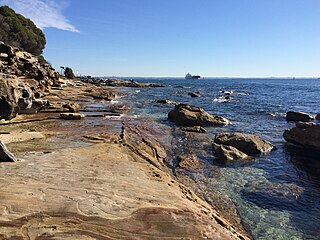
The Kamay Botany Bay National Park is a heritage-listed protected national park that is located in the eastern part of Botany Bay in Sydney, New South Wales, Australia. The 456-hectare (1,130-acre) national park is situated approximately 16 kilometres (9.9 mi) south-east of the Sydney central business district, on the northern and southern headlands of Botany Bay. The northern headland is at La Perouse and the southern headland is at Kurnell.

Arncliffe is a suburb in southern Sydney, in the state of New South Wales, Australia. Arncliffe is located 11 kilometres south of the Sydney central business district, in the local government area of the Bayside Council.
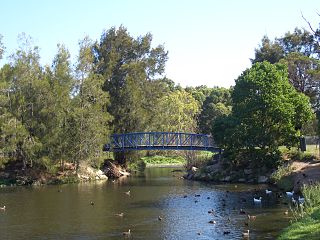
Rockdale is a suburb in southern Sydney, in the state of New South Wales, Australia. Rockdale is located 13 kilometres south of the Sydney central business district and is part of the St George area. Rockdale is one of the administrative centres for the local government area of the Bayside Council. Since 1985 Rockdale has been a twinned city with Bitola, in the Republic of Macedonia.
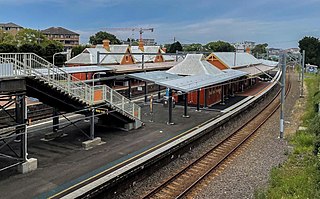
Arncliffe railway station is a heritage-listed railway station located on the Illawarra line, serving the Sydney suburb of Arncliffe in Bayside Council. It is served by Sydney Trains T4 line services. It was added to the New South Wales State Heritage Register on 2 April 1999.
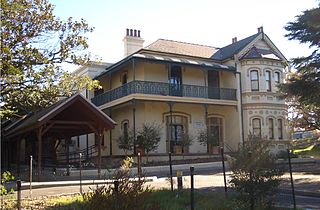
Turrella (;) is a suburb in southern Sydney, in the state of New South Wales, Australia. Turrella is located 10 km south-west of the Sydney central business district on the southern bank of Wolli Creek in the local government area of Bayside Council.

Wolli Creek is a suburb in southern Sydney, in the state of New South Wales, Australia. It sits beside the Wolli Creek and Cooks River waterways. Wolli Creek is situated between the suburbs of Arncliffe and Tempe, 10 kilometres south of the Sydney central business district and is part of the St George area. Wolli Creek is in the local government area of Bayside Council.

Banksia is a suburb in southern Sydney, in the state of New South Wales, Australia. Banksia is located 12 kilometres south of the Sydney central business district, in the local government area of the Bayside Council and is part of the St George area.

The Malabar Headland is a heritage-listed former public recreation area and military installation site and now nature conservation and public recreation headland area located at Franklin Street, Malabar in the City of Randwick local government area of New South Wales, Australia. It is also known as Long Bay Rifle Range, Anzac Rifle Range and Boora Point. The property is owned by the New South Wales Government. It was added to the New South Wales State Heritage Register on 22 July 2005.

The Botany Water Reserves are a heritage-listed former water supply system and now parkland and golf course at 1024 Botany Road, Mascot, Bayside Council, Sydney, New South Wales, Australia. It was designed by City Engineers, W. B. Rider, E. Bell (1856–1871), and Francis Bell (1871–1878). It is also known as Botany Dams, Botany Swamps, Botany Wetlands, Mill Stream, Bridge Pond, The Lakes Golf Club, Eastlakes Golf Course, Bonnie Doon Golf Club, and Astrolabe Park. The property is owned by Sydney Water, an agency of the Government of New South Wales. It was added to the New South Wales State Heritage Register on 18 November 1999.
The Kyeemagh Market Gardens are heritage-listed market gardens at Occupation Road, Kyeemagh, Bayside Council, New South Wales, Australia. It was established from 1892. It is also known as Occupation Road Market Gardens, Chinese Market Gardens and Rockdale Market Gardens. It was added to the New South Wales State Heritage Register on 2 April 1999.
Toomevara Lane Chinese Market Gardens is a heritage-listed market garden at Toomevara Lane, Kogarah, Bayside Council, New South Wales, Australia. It is also known as Rockdale Market Gardens and Chinese Market Gardens. It was added to the New South Wales State Heritage Register on 2 April 1999.

Western Outfall Main Sewer is a heritage-listed former sewage farm outfall sewer and now ocean outfall sewer near Valda Avenue, Arncliffe, Bayside Council, New South Wales, Australia. It was designed by the New South Wales Department of Public Works, who built the sewer from 1895 to 1898. It is also known as SWSOOS No. 1, Western Main Carrier and Western Main Outfall Sewer. The property is owned by Sydney Water. It was added to the New South Wales State Heritage Register on 15 November 2002.

The Cooks River Sewage Aqueduct is a heritage-listed sewage aqueduct located at Pine Street, Earlwood, New South Wales, Australia. It crosses the Cooks River to Thornley Street, Marrickville. It was designed by Sewerage Construction Branch and NSW Department of Public Works and built during 1895 by J. F. Carson, contractor. The property is owned by Sydney Water, an agency of the Government of New South Wales. It was added to the New South Wales State Heritage Register on 18 November 1999.

The Wolli Creek Aqueduct is a heritage-listed sewage aqueduct located at Unwin Street, Earlwood, City of Canterbury-Bankstown, New South Wales, Australia.
The Chinese Market Gardens is a heritage-listed market gardens at 1-39 Bunnerong Road, La Perouse, City of Randwick, New South Wales, Australia. It is also known as Chinese Gardens La Perouse, Phillip Bay, Matraville and Randwick. The property is Crown land and is owned by NSW Department of Industry, a department of the Government of New South Wales. It was added to the New South Wales State Heritage Register on 13 August 1999.

Yiu Ming Temple is a heritage-listed Chinese temple at 16–22 Retreat Street, Alexandria, City of Sydney, New South Wales, Australia. Built in 1908–1909, Yiu Ming Temple is one of the oldest surviving Chinese temples in Australia and a globally rare intact example of the traditional Chinese village temple form. While commonly known as the "Yiu Ming Temple", its formal name is Hong Sheng Gong or Hung Sheng Gong, which indicates that it is a Hung Shing Temple. It is also sometimes known as Yiu Ming Hung Fook Tong Temple(Chinese: 要明洪福堂), which is strictly the name of the previous temple used by the same community. It was added to the New South Wales State Heritage Register on 24 September 1999.
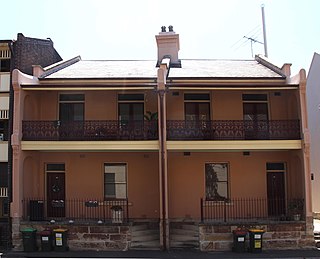
113–115 Gloucester Street, The Rocks is a heritage-listed terrace house located in the Long's Lane Precinct at 113–115 Gloucester Street, in the inner city Sydney suburb of The Rocks in the City of Sydney local government area of New South Wales, Australia. It was built during 1881. It is also known as Longs Lane Terraces/Precinct. The property is owned by Property NSW, an agency of the Government of New South Wales. It was added to the New South Wales State Heritage Register on 10 May 2002.

32–36 and 38–40 Gloucester Street facades, The Rocks is a heritage-listed former residence located at 32-36 and 38-40 Gloucester Street, in the inner city Sydney suburb of The Rocks in the City of Sydney local government area of New South Wales, Australia. It was built during 1885. It is also known as part of development known as 40 Gloucester Street. The property is owned by Property NSW, an agency of the Government of New South Wales. It was added to the New South Wales State Heritage Register on 10 May 2002.

The Dundee Arms Hotel, commonly called The Dundee Arms, is a heritage-listed pub located at 171 Sussex Street, in the Sydney central business district, in the City of Sydney local government area of New South Wales, Australia. It was built in 1860. It was added to the New South Wales State Heritage Register on 2 April 1999.

Valley Heights Steam Tram Rolling Stock is a heritage-listed collection of tramway machinery at 17b Tusculum Road, Valley Heights, City of Blue Mountains, New South Wales, Australia. It was built from 1889 to 1891. The property is owned by Steam Tram and Railway Preservation (Co-op) Society. It was added to the New South Wales State Heritage Register on 21 October 2016.

















